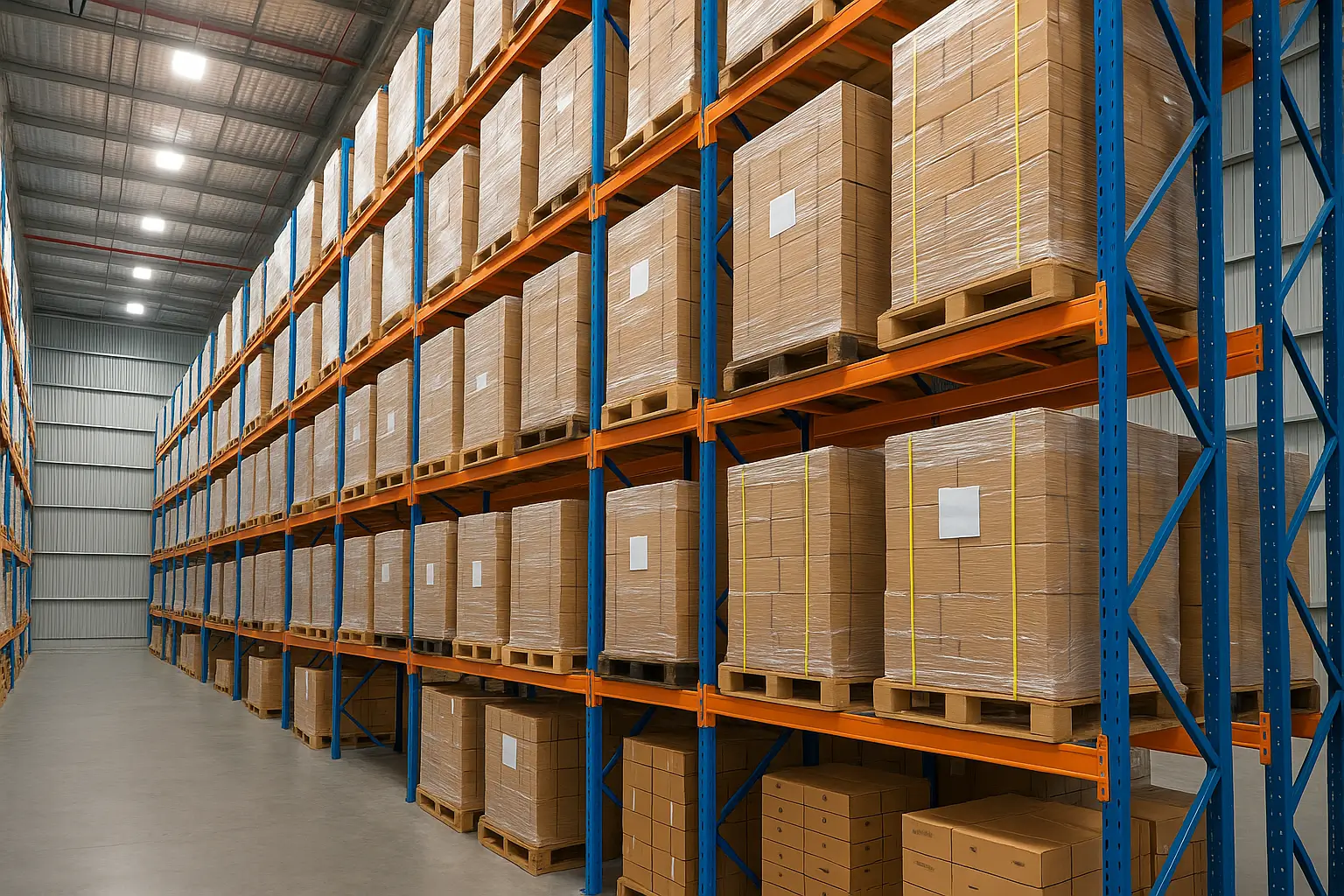This well-known principle in logistics shows when performance starts to drop sharply. This happens even if space use only goes up a little. This report looks at why this happens. It explores the math behind queueing theory[1]. It also points out the challenges that come up when warehouses hit this key stage.
The 85% Occupancy Threshold in Warehouse Management
The 85% occupancy rule is well-established in logistics and warehouse management literature. When storage capacity exceeds 85%, productivity metrics begin to show marked decline. The rule was made to stop warehouses from hitting 100% capacity. If they do, operations can get stuck completely.
Some top warehouses with good management systems can work at rates up to 90%. However, this relies on how accurate their systems are and how skilled the staff is. Third-party logistics companies often maximize their space. This approach helps them earn more money. However, even they see diminishing returns when occupancy goes over 85%.
Industry Consensus and Application
The 85% rule applies to pallet rack storage and all areas in a distribution center. This includes receiving, shipping, and processing areas. MWPVL International found that going beyond this utilization level leads to lower productivity. The drop in efficiency isn’t linear. It follows an exponential curve. Each percentage point over 85% brings bigger operational challenges.
Queueing Theory: The Mathematical Explanation
The 85% rule is based on queueing theory[1]. A.K. Erlang developed this theory in 1904 for telephone systems. It also applies to warehouse operations. Queueing theory helps us understand waiting times and congestion. As usage gets closer to capacity, these issues worsen.
The Non-Linear Relationship Between Utilization and Efficiency
The key idea in queueing theory that explains the 85% phenomenon is shown in the Kingman (or VUT) formula[2]:
Small rises in utilization can lead to larger increases in wait times and congestion. As utilization nears 100%, the denominator (1-Utilization) gets close to zero. This leads to a big increase in wait times. This math shows why a warehouse runs well at 80% capacity but struggles at 90%.
Real-World Impact of Queueing Effects
In practical terms, this queueing relationship manifests in alarming ways. Studies show that a 20% rise in arrival rates can boost system processing time by 150%. Warehouse managers see big drops in efficiency when usage goes over 85%. This is due to the disproportionate response. This phenomenon is clear in warehousing. There, both arrivals (incoming goods) and processing (retrievals, putaways) show natural variability.
Operational Challenges at High Occupancy Rates
Congestion and Restricted Movement
High occupancy leads to clear physical congestion in the warehouse. When a facility exceeds 85% capacity, pallet movement becomes significantly restricted. Operations that previously required single movements now require multiple actions to complete. Workers move pallets not to be productive, but to clear paths to items they need.
This congestion causes a chain reaction. Each extra handling operation takes up more space. It also raises the chances of needing more movements for future operations. The warehouse gets stuck in a negative feedback loop. When efficiency drops, it leads to even more losses in efficiency.
Decreased Accessibility and Visibility
As rack utilization increases beyond 85%, reaching specific items becomes increasingly challenging. Warehouse staff must move through tight spaces. They often reach at odd angles to grab products. This not only slows down operations but increases the physical strain on workers.
Visibility also diminishes in highly utilized storage environments. Items are harder to find and recognize. This raises the chance of picking mistakes. Even with advanced inventory systems, checking stock can be hard when you can’t see it. Products might be “in stock,” but they can be hard to access. This can disrupt other operations significantly.
Multiple Handling and Extra Work
A major efficiency drain in busy places is the need for multiple handling tasks. In a full warehouse, getting to a specific pallet may mean moving several others first. This causes a “Product A/Product B” issue. To get one item, you must move other items that you don’t need right now.
These additional touch points dramatically increase labor costs and processing times.
Improper Storage Practices
As occupancy exceeds 85%, proper storage protocols often break down. Aisles become impromptu storage locations, further restricting movement and creating safety hazards.
This ad-hoc method makes it harder to plan the warehouse layout and workflow. Improvised storage solutions usually don’t fit the best picking paths or inventory rules. Storing pallets on the floor instead of racks causes extra delays. These pallets will need to be moved to their correct spots later.
Safety Concerns and Product Damage
Safety deteriorates noticeably as occupancy exceeds 85%. Congested aisles and improper storage create hazardous conditions for both personnel and equipment. Workers must use narrower pathways than planned. This raises the chances of collisions between forklifts or with racking systems.
Product damage rates also increase significantly as occupancy exceeds the 85% threshold. Items get handled more frequently, often under rushed conditions and in constrained spaces. Damaged goods hurt profits. They mean lost inventory value and extra processing work.
Managing Warehouse Capacity Effectively
Strategic Space Utilization
Effective warehouse management requires maintaining occupancy rates below the critical 85% threshold. You can achieve this by using different strategies. These include improving storage setups, rearranging pallet racks, and optimizing warehouse layouts. Using vertical space well with the right racking systems can boost capacity. This method helps prevent congestion caused by high horizontal density.
Checking inventory age and turnover rates helps clear out overstock and old items. This can free up valuable space. Formal slotting programs keep fast-moving items easy to reach. Meanwhile, slower-moving inventory is placed to lessen its effect on daily operations.
Technological Solutions
Advanced warehouse management systems (WMS) can help maintain efficiency even as utilization increases. These systems show storage availability in real time. They also optimize putaway and picking tasks. This helps reduce travel time and handling needs. A good WMS can boost a warehouse’s capacity. It does this by making sure space use matches the workflows.
Warehouses running at 85% capacity can use demand forecasting systems. These systems warn of potential issues ahead. This allows managers to proactively address space constraints before they impact operational performance.
Balancing Occupancy and Efficiency
The 85% rule in warehouse management is not just a saying. It is based on math and real-life experience. Queueing theory explains why efficiency drops sharply as usage nears capacity. Observations in operations show the real challenges that arise at this point.
Warehouse managers need to balance two key goals. First, they want to make the most of their space. Second, they must keep operations running smoothly and efficiently. Running above 85% capacity might seem like a good way to use assets. It often leads to higher costs for labor, time, damage, and customer satisfaction. These costs usually outweigh any savings in space.
Grasping the 85% threshold helps logistics experts make smart choices. This knowledge guides them in planning capacity, timing expansions, and investing in technology. By respecting this boundary, warehouses can balance storage density with flow and accessibility. This balance is key for efficient operations.
References
We value truthful content. 2 sources were referenced during research to write this content.
- (2010). An application of queuing theory to SIS and SEIS epidemic models. Mathematical Biosciences and Engineering. American Institute of Mathematical Sciences (AIMS). http://doi.org/10.3934/mbe.2010.7.809
- Shanthikumar, J. G., Ding, S., & Zhang, M. T. (2007, October). Queueing Theory for Semiconductor Manufacturing Systems: A Survey and Open Problems. IEEE Transactions on Automation Science and Engineering. Institute of Electrical and Electronics Engineers (IEEE). http://doi.org/10.1109/tase.2007.906348



Leave a Reply